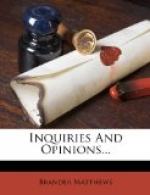To this illustration from architecture may be added another from sculpture, as suggestive and as useful in showing how a conquest of technical difficulty is likely ever to increase the resources of the art. The sculptor of the statue of Lincoln, which ennobles a park of Chicago, was instructed that the work of his hands was to stand upon a knoll, visible from all sides, stark against the sky, unprotected by any background of entablature or canopy. The gaunt figure of Lincoln is not a thing of beauty to be gazed at from all the points of the compass; and the stern veracity of the artist would not permit him to disguise the ill-fitting coat and trousers by any arbitrary draperies, mendaciously cloaking the clothes which were intensely characteristic of the man to be modeled. To shield the awkwardness of the effigy when seen from the rear, a chair was placed behind it; and so the sculptor was led to present Lincoln as the Chief Magistrate of the Republic, arisen from the chair of state, to address the people from whom he had received his authority. And thus, at that late day, at the end of the nineteenth century, Mr. Saint-Gaudens did a new thing; altho there had been standing statues and seated statues, no sculptor had ever before designed a figure just rising from his seat.
It is by victories like these over technical difficulties that the arts advance; and it is in combats like these that the true artist finds his pleasure. The delight of battle is his, as he returns to the attack, again and again, until at last he wins the day and comes home laden with the spoil. The true artist hungers after technic for its own sake, well knowing the nourishment it affords. He even needlessly puts on fetters now and again, that he may find sharper zest in his effort. This ravenous appetite for technic leads many an artist to go outside his own art in search of unforeseen but fascinating difficulties. The painter is tempted to stretch his muscles by a tussle with the unknown obstacles of the sculptor; and the sculptor in his turn contends with the limitations of the painter. Michelangelo called himself a sculptor and pretended to be no more; but in time he took up the craft of the architect, of the painter and of the poet. And this interchange of field in search of new worlds to conquer seems to be characteristic of the great periods of artistic activity and achievement. In all such periods, the more accomplished craftsmen have never wearied of technical experiment to the constant enrichment of the processes of their art.
It is the uncreative critics, it is never the creative craftsmen, who dwell on the danger of taking too much interest in technic. The critics may think that the more attention the artist pays to his manner, the less he has for his matter, and that he is in peril of sacrificing content to form. But the craftsmen themselves know better; they know that no one may surely separate manner and matter, form and content,




